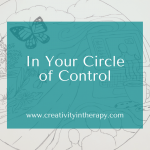
In the last post, I touched on solution-focused and strengths-based approaches when I shared a review of the book Solution Art: A Textbook of Art- and Resource-Oriented Work. I wanted to follow-up this week with some more art directive information when taking a solution-focused approach with your clients.
At its core, the solution-focused approach believes that clients already have the strengths, resources, and knowledge that they need to be able to solve their “problem” and move forward. However, they often feel stuck and hopeless, so the solution-focused therapist helps them to feel more empowered, uncover their strengths and resources, identify past successes, and believe that achieving their goals is possible. Instead of acting as the “expert” who will tell the client what to do, the therapist will act in a more collaborative role. Although learning about solution-focused therapy often leads to a focus on specific techniques like “the miracle question” and scaling, it’s also important to remember that a strong therapeutic relationship is also an important part of what makes solution-focused approaches successful. When the therapist is reflecting back to the client that they believe in their strength and their ability to move forward, that helps the client to begin believing in it for themselves.
Note – Although the common thread in these two posts is the focus on being solution-focused and strengths-based, these directives are very different from the expressive arts approach of Intermodal Decentering that is shared in the Solution Art book. In the book, Knill and Eberhart primarily share examples of giving directives that are intended to serve as an experiment in doing something different and stepping away from the problem. The value and insight come from the creative experience and then the projection on and exploration of the created work. Their prompts are intended to help clients get unstuck, work within limited conditions, access inner resources to be successful, and see things from a different perspective. Examples in the book include directives like (1) Choose only 2 colors of oil pastel. Draw a single line with each color, as long as you want, but only one line or (2) Arrange the provided objects into an installation artwork.
The solution-focused art therapy directives shared below provide some alternative ideas for how you can bring solution-focused and strength-based approaches into your work with your clients.
1. Past Success – Helping clients to identify and explore past successes is one way to help them recognize their own capacity to overcome challenges, as well as begin to uncover their own personal strengths, coping skills, and tools. Keep in mind that this prompt can and should be adjusted so that it best speaks to what your client is struggling with and what you hope for them to get out of the experience. You may also consider whether your client will get the most out of the prompt by doing the art first with their own self-reflection or if it is better to take some time to talk together and identify that success through discussion before giving the directive. Art directive – Show a time that you felt successful (happy, capable, proud, brave, etc.) or were able to get through a difficult situation.
2. Miracle Question – This is probably the first thing that most counselors and therapists think of when they think of solution-focused therapy. The miracle question translates well into an art directive – “Suppose tonight you go to bed and go to sleep as usual. And during the night, a miracle happens. And the problem vanishes. And the issues that concern you are resolved, but you’re still asleep. Therefore, you don’t know that the miracle has happened. When you wake up tomorrow, what will be the first things that will tell you that the miracle has happened? How will you know that the transformation has occurred?” You can direct the client to respond to the question first through art instead of verbal conversation.
3. Storyboard – Another aspect of solution-focused therapy is helping the client to identify the small, incremental steps that will move them closer to their goal. Creating a visual storyboard is one way to practice this. Start with an image that shows where/how things are now (problem state), then create an image of achieving the goal at the end. In between, fill in images that represent the small steps toward reaching the goal, break it down into several stages that feel manageable for the client.
4. Strengths Collage – Invite the client to create a collage with images that show their strengths, resources, and positive qualities. Keep in mind that this may be a very difficult prompt for some clients, especially if they are depressed or struggle with self-worth. One way to address that is to ask the client to look through the collage images without searching for anything specific, then set as any image that resonates as a positive part of themselves when they see it. You can also print out a list of strengths and have the client go through and circle words that relate to them, provide feedback about the strengths that you see in the client, and invite them to ask trusted friends or family members to help them recognize their strengths.
5. Future Self Portrait – This is a great example of the power of art to make something intangible or hard to believe feel more concrete and real. Although related to the miracle question or other goal-setting directives, this directive really encourages the client to focus on themselves, not the world or people around them. Art directive – Imagine a future time where your concerns have resolved and you have reached your desired goals, depict yourself in that future state.
With all these directives, feel free to allow clients to work with whatever art medium will be best for them. They can generally be adapted for drawing, painting, collage, sculpture, or sandtray.
I’d love to hear your thoughts! Do you use any of these solution-focused directives in your work?
Carolyn Mehlomakulu, LMFT-S, ATR-BC is an art therapist in Austin, Texas who works with children, teens, and families. For more information about telehealth and online therapy, individual therapy, child and teen counseling, and art therapy services, please visit: www.therapywithcarolyn.com. Carolyn is also the author of The Balanced Mind – A Mental Health Journal, a guided journal that combines writing and art prompts to support your mental health.
This blog post contains affiliate links and I earn a small commission for your purchases. This blog is not intended to diagnose or treat any mental health conditions. All directives, interventions, and ideas should be used by qualified individuals within the appropriate bounds of their education, training, and scope of practice. Information presented in this blog does not replace professional training in child and family therapy, art therapy, or play therapy. Art therapy requires a trained art therapist.





I love this! Clients have so many strengths and these interventions are excellent ways to shine light on them.
Thank you!